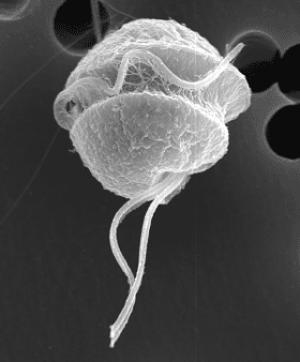Pfiesteria
A Microbial Biorealm page on the genus Pfiesteria

Classification
Higher order taxa
Eukaryota; Alveolata; Dinophyceae
Species
Pfiesteria piscicida
Pfiesteria shumwayae
|
NCBI:Taxonomy Genome |
Description and Significance
Pfiesteria is contained within the phylum Dinoflagellata. It is a recently-discovered class, not identified until 1988, by Dr. JoAnn Burkholder. It was discovered at North Carolina State University. However, the species Pfiesteria shumwayae, also discovered by Burkholder, was not detected until 1995. This species was not confirmed until 2000. P. shumwayae seems to prefer water with high levels of nirogen, while P. piscicida apparently prefers a high-phosphorous environment. As a result of all the attention being paid to Pfiesteria, several similar organisms have been discovered. They are called Pfiesteria Complex Organisms. At present time, researchers are still unsure about the impact these organisms have on humans. Although there has been a great deal of research performed on Pfiesteria, concrete conclusions are not yet available regarding most every aspect of these organisms. Pfiesteria remains highly controversial.
Genome Structure
One way to identify whether or not a Pfisteria species is at a toxic stage of the life cycle is through gene identification, as demonstrated by Coyne et. al. (2004). The genes can then be used to detect toxic Pfiesteria in the environment.
Cell Structure and Metabolism

NC State University Center for Applied Aquatic Ecology

Morphologically, Pfiesteria have a great deal in common with most other forms of Dinoflagellata. For example, a flagellum winds around the center of the organism. Pfiesteria are heterotrophic organisms. They feed on bacteria and algae. They also feed off the skin of fish, which they break down with the toxins they emit. In addition, Pfiesteria piscicida can also function as a photosynthetic autotroph.
The toxicity of Pfiesteria species depends on the stage of their life cycle. Organisms often temporarily lose toxicity when there is an absence of fish. It has been suggested there are at least 24 stages to the life cycle. These include flagellated, amoeboid, and encysted stages. Twenty of the stages are harmless, four are toxic. Cysts are dormant, where flagellate and amoeboid Pfiestieria can be toxic. However, in 2002, controversy surrounding this hypothesis emerged. Studies published in that year challanged the methods, findings, and objectivity of Burkholder and other researchers who claimed this complex life cycle existed. For example, in research conducted by Dr. Wayne Litaker, an amoeboid stage was not found. Although these organisms are still known to be toxic, new research suggests a simpler life cycle that is more representative of dinoflagellates.
Ecology
Pfiesteria can be located all over the world, although some of the most notable outbreaks have occurred in the United States, running between Delaware and North Carolina. They usually bloom in estuaries, as well as costal rivers and sounds. They are not usually found in open water, nor in inland rivers or lakes. Pfiesteria species are harmful, but not toxic the way Alexandrium species are. Instead, they kill fish by feeding on their skin. They also excrete ichthyotoxins. Research indicates that Pfiesteria are also harmful to humans, causing Possible Estuarine Associated Syndrome, as well as neurological problems similar to those caused by Alexandrium. The symptoms of Possible Estuarine Associated Syndrome include: headache, dizziness, skin rashes, nausea, muscle cramps, and short-term memory loss. However, not all Pfiesteria organisms are toxic. Even non-toxic species can still be harmful to the environment. If their numbers grow too high, they can depelete the resources in their area.
References
Advanced Technology Environmental Education Center.
Harmful Algal Blooms in North Carolina. "More Information on Pfiesteria." 25 November 2003. Accessed 1 July 2005.
NC State Univeristy Center for Applied Aquatic Ecology.
News in Science. "More controversy surrounds Pfiesteria." 20 June 2002. Accessed 1 July 2005.
State of North Carolina Department of Health and Human Services. 'What is Pfiesteria?" October 1999.
University of Iowa Hygienic Laboratory. "Pfiesteria piscicida." 2004. Accessed 1 July 2005.
